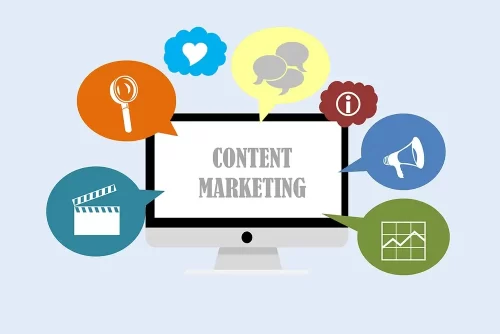Converting visitors into leads is one of the main goals of website copy. If your copy fails to connect with your audience, you may not get the results that you want from your marketing campaigns. Here is a collection of proven tips for writing high-converting copy.
AI + Human Edited Content Creation.
Only $0.01 per word!

1. Create a Catchy Headline
Users scroll through search results hoping to find the information they want. A catchy headline can help grab their attention.
The headline is the first thing that they see. It gives you a way to stand out from the other results on the page. Use these suggestions to craft better headlines:
- Keep it short
- Don’t use passive language
- Summarize your message
- Add a number
- Match the brand’s voice
For best results, try to use eight or fewer words for headlines. It makes your headline easier to read, which helps you attract more clicks.
Your headline should be direct and firm. Avoid passive language and words or phrases that create uncertainty, such as “may” or “should.”
Summarize the main point of your content. Readers should know exactly what your article is about based on the headline. For example, “10 Proven Tips for Writing High-Converting Copy” clearly states what you’ll find in this article.
Using numbers may also attract more visitors. For some reason, search results with numerals often have higher click-through rates.
Match the style of the headline to the brand's image. It’s difficult but can help with brand consistency. For example, some companies may prefer professional, casual, or humorous content.
2. Learn More About Your Audience
Understanding your audience helps you write copy that converts. You’re more likely to produce content that appeals to them.
Use analytics tools to research their online behavior. Find out which pages visitors spend the most time on.
Monitoring social media channels can also help you get to know your audience better. Check out Facebook, Instagram, and TikTok to see what they’re saying about your brand and competitors.
Use surveys to learn more about your customers. The questions that you include can help you uncover your customer’s preferences.
Use this research to identify their needs and pain points. Tailor your content to better match these aspects.
3. Research Keywords
Use keyword research to find the terms that your target audience is searching for. Add these keywords naturally in your copy.
Keywords are integral to your SEO, as they help ensure that your content reaches the right audience. They let you know how people are searching for specific topics.
Online keyword tools, such as the Google Ads Keyword Planner, help you find the best keywords for your content. You can view suggestions for keywords related to your products or services.
These tools also let you view estimates on the total number of searches for different keywords. You can use this to pick keywords with the right amount of competition and volume.
4. Write in the Second Person
Write as if you’re speaking directly to your audience. Writing in the second person is a common choice when offering advice or instructions to a reader. It helps make your content more personal.
When you address the reader as “you,” you create a sense of connection. This can increase engagement and conversions.
5. Keep Things Simple
Make sure that your text is readable. Use mostly short sentences so that your content is more scannable and easier for all types of readers.
The average adult reads at the 7th- to 8th-grade level. About 43% of adults in the US have low literacy skills.
Document editors such as Microsoft Word can estimate the readability of your content using the Flesch Kincaid Reading Level. Aiming for a high readability score means that more people are likely to understand your main message.
While it’s not always possible to write for an 8th-grade level, especially when covering technical topics, you can strive to keep things short. Use simple language and short sentences.
6. Avoid Using Power Words
Power words are added to make content more impactful but shouldn’t be used frequently. Power words work well in headlines and advertising. They’re not as effective for website copy and blog posts. These words make your content come across as salesy.
Examples include:
- Exciting
- Impressive
- Remarkable
- Amazing
- Fantastic
Don’t make big claims. Focus on the real benefits of the products or services.
7. Use Social Proof
Add customer testimonials, case studies, and reviews to boost your credibility. Scatter these throughout your landing pages and marketing campaigns.
Including this type of social proof boosts your conversion rates. The positive feedback from real people makes potential customers more likely to trust your brand.
You should also ask satisfied customers to share their experiences. This is how you gain more testimonials for your marketing campaigns.
8. Improve Your Content with AI
Use AI tools to help with your content creation. You can use AI-powered grammar checkers to catch errors that your document editor overlooks.
You can also try using generative AI tools to come up with ideas for your articles. Have these tools generate topics that you can pick from for your next blog post.
Don’t use these same tools to generate your articles from scratch. Generative AI platforms can make mistakes and produce inferior content. Use them to enhance your writing process.
9. Implement the AIDA Model
Follow the AIDA model to write persuasive copy. Here’s the steps:
- Attention
- Interest
- Desire
- Action
You first need to grab the reader’s attention. Along with a catchy headline, you need to ensure that the opening statement keeps them hooked and wanting to learn more.
After attracting attention, you need to generate interest. Explain the unique selling point of your product or service.
You next create desire by discussing how your solutions can solve a specific problem. Provide real examples of how users may benefit from your offering. Follow this up with your call to action (CTA).
10. Create an Effective Call to Action (CTA)
Your CTA is the final attempt to convert the reader. Make sure that your CTA is concise and compelling.
Use action-oriented language. This encourages the reader to take the desired next step, such as signing up for a newsletter or making a purchase.
Now it’s time to put these tips to use. Review each of the suggestions as you write your next piece of content. From writing a catchy headline to following the AIDA model, take your time to craft compelling text.
100% human-written content by native English writers
OUR BLOG




